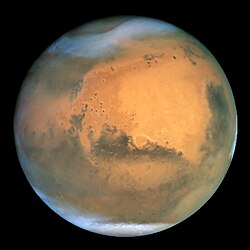Mars Polar Lander
 Konceptritning av Mars Polar Lander på Mars | |
| Status | Misslyckad |
|---|---|
| Typ | Landare |
| Organisation | NASA |
| Större entreprenör | Martin Marietta Corporation |
| NSSDC-ID | 1999-001A[1] |
| Uppdragets varaktighet | 11 månader |
| Uppskjutning | |
| Uppskjutningsplats | Cape Canaveral Air Force Station, SLC-17A |
| Uppskjutning | 3 januari 1999, 20:21:10 UTC |
| Uppskjutningsfarkost | Delta II |
| Landning | |
| Landning | 3 december 1999 (planerad) |
| Egenskaper | |
| Massa | 583 kg |
| Dimensioner | 1.06 m hög, 3.6 m bredd |
Mars Polar Lander (tidigare känd som Mars Surveyor 98 Lander) var tillsammans med Mars Climate Orbiter en av farkosterna i Mars Surveyor 98-programmet. Mars Polar Lander innehöll också Deep Space 2, som skulle tränga ner i ytan på Mars. De två sonderna skulle undersöka Mars väder, klimat och vatten- och koldioxidinnehåll för att kunna undersöka om det finns långtids och periodiska klimatförändringar. Kontakten med farkosten förlorades strax före inträdet i Mars atmosfär.
Referenser
Noter
- ^ ”NASA Space Science Data Coordinated Archive” (på engelska). NASA. https://nssdc.gsfc.nasa.gov/nmc/spacecraft/display.action?id=1999-001A. Läst 1 april 2020.
Se även
| ||||||||||||||||||||||||||||||||||||||||||||||||||||||||
Media som används på denna webbplats
NASA's Hubble Space Telescope took the picture of Mars on June 26, 2001, when Mars was approximately 68 million kilometers (43 million miles) from Earth — the closest Mars has ever been to Earth since 1988. Hubble can see details as small as 16 kilometers (10 miles) across. The colors have been carefully balanced to give a realistic view of Mars' hues as they might appear through a telescope. Especially striking is the large amount of seasonal dust storm activity seen in this image. One large storm system is churning high above the northern polar cap (top of image), and a smaller dust storm cloud can be seen nearby. Another large dust storm is spilling out of the giant Hellas impact basin in the Southern Hemisphere (lower right).
Mars Polar Lander will use an articulated robotic arm to dig trenches to collect soil samples. This terrain near the south pole is believed to consist of layers of soil and ice built up over many years (similar to tree growth rings). The composition of the layers may reveal clues to past climatic conditions.


